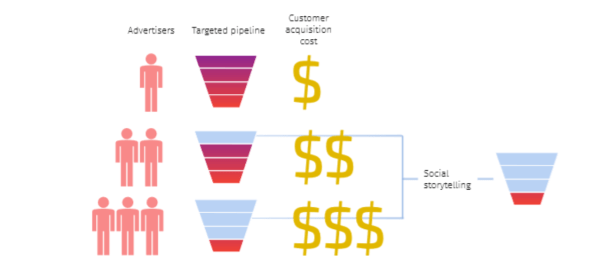Any media is a combination of channel and information. Media uses platform to build the channel to communicate with its audience. An audience chooses the media based on a suitable platform and the information it provides. Traditional media used to control their platforms completely. With the growth of social media, their pages became one of many on the platform. Those platform changes affected income source. Here are the media evolution milestones based on those two determining factors.
The infographic demonstrates the evolution of media platform and revenue source.

Print media
It was a long age of print media dominance. There was no other way to distribute information and to connect with each other, other than through publications in newspapers or magazines. The media brand was influential, and subscribers and advertisers were its income source.
Internet media
The emergence of Internet prompted print media to create their own web pages. While the subscription-based part of their income reduced, their business models didn’t change. Banners and sponsored articles became their main source of revenue.
Social media
The struggle between the media and the platform started with the introduction of social media. Internet media use platform to attract an audience and to lure it to visit their web pages.
This does not align with platform goals.
The biggest asset of social media is user data and user-generated content. Their main source of revenue is highly targeted advertisement. While traditional internet-media also have become an element of the advertising networks, they have to share their revenue with content creators. The targeted ads generate too little revenue, that is also cut by an intermediary. Media just can’t produce high-quality content with this source of income alone.
Meanwhile, social media have demonstrated the influence of individuals.
Next generation media
Closer and more instant interactions have become the main trend developing in the new media. This leads to the growth of messenger-like media and streaming functions. With our friends, we prefer to chat in messengers. To experience more, we go to specialized platforms, which display videos, photos, streams or blog posts.
The influencers are rising and claim their share of income. Traditional social platforms manipulate feeds and content to increase their revenue while authors of good content and active communities receive no support. The new revenue model of social media has to involve direct payments. Let’s dive into the future of media and understand how it will benefit all of us.
Trends
How is social media landscape changing? Major platforms introduce a multitude of ideas and approaches with the ultimate goal – to stay influential and increase revenue.
Money has to be shared
Targeting used to be the goldmine for both advertisers and platforms. Companies just reaped customers who were ready and willing to buy. The art of targeting has become popular and now it is a very sophisticated process, while an audience is an object of interest for many companies. Within the traditional model it is becoming more difficult for brands to stand out there. They need influencers to create engaging stories for the brand audience. A creative approach will be more compelling for advertisers.
Media implements many options such as paywall, subscriptions and micro-payments. Direct payments for the specific content or to the user also become more and more popular.

The infographic shows trends in targeting. The bid competition increases and customer acquisition costs become higher. Companies are trying to target more precisely to reach potential customers. While the customers who are ready to buy attract the most attention, the top of the pipeline stays untreated. Brands can cover them by storytelling through different media, platform, and influencers and make real fans of these customers.
Outstanding content breakthrough
The business model of social platforms affects the content quality too. The requirements for content have become low, it just has to grab attention quickly. The channel has become more important for all the parties of social interactions: if you can attract the audience you can earn, regardless of the content quality.
Nowadays social media and other web sites are flooded with low-quality content. Platforms apply different approaches to handle it: moderators, AI, censorship. For example, YouTube introduces manual moderation and additional requirements for partnered channels. Huffington Post announced it will no longer work with contributors on its U.S. site.
The best way to identify quality content is to let users pay for it directly. Experts, educators, and outstanding showmen would thrive eventually.
People build trust
Don’t forget the reason why we all gather here: to communicate openly with someone we like. Social media platforms want us to stay more on their pages and to click adds. For example, Facebook applies algorithms to make people stay longer there, at the same time audience engagement decreases. Facebook has become less social, more media: we scroll feed looking for stories, entertainment and news, and don’t spend the time to comment, like or share.
The personal interactions move to other mediums, such as messengers and streams. Influencers gather people in communities and use group chats, streams, and comments. Communities motivate people to interact, rather than be merely informed. Information, news, memes, and other content spread very fast across communities, while algorithms address long-term processes.
The new business model
While most traditional networks and media are trying to catch some new trends, the new business model arises. It is that pivotal moment when media just can’t use additional attributes to stay on the top. The new model would not complement traditional platforms, it substitutes them as they don’t change their primary source of revenue based on targeting ads.
The social network, which wins the future, has to combine new business model, new technologies and the new type of content which attracts the young audience. Young people change their preferences fast. Currently, the most popular global social network is just number four in their top and tends to become even less popular. And this list is changing continuously.
Let’s take a closer look at the new business model of media and the example that illustrates it. Monoreto is the social platform which brings together all trends and illustrates the upcoming model. This platform is based exactly on the new principle – direct payments to support excellent content creators.

The core of the platform is content, personal communications, and instant feedback. The platform allows to easily launch live broadcasts, create stories with photos and 10-second videos with overlaid text, and publish different types of content including photo and video.
Influencer: produces content and interact with users. Tells a brand’s story.
Direct donations are the basis of the new model
The donation model of Monoreto implements blockchain technology. The minimum transaction is equal to 5 cents in Monoreto tokens (or more, up to donator), which users transfer with their likes.
There are several reasons why users already donate and will continue to do so:
They want to interact with a public person and to attract attention. During live streams donations have become a very popular way to interact with a broadcaster, to ask him to say or do something. This kind of interactions with influencer become a valuable experience.
Gamification: there are a plenty of ways to turn gratitude into entertainment. In Monoreto these are quizzes, lotteries, and competitions. For example, a world-famous sportsman is able to publish a post and announce that top 3 active donors to the post will get the opportunity to meet him (for dinner, at a training club, etc.) Millions of followers and fans crave to win the prize. The media easily and transparently conveys the procedure, and winners will gain recognition by everyone and will get their moment of glory.
They also want to be stars, so they explore the platform, interact with influencers and gradually become more active and start to donate. Donations help to stand out for users and even for brands, because accounts who “donate” likes promote their posts in the newsfeed. Brands are encouraged to tell their stories directly to the audience. By liking quality content of other users, a business account climbs upwards on Monoreto’s smart feed and gives information to potential consumers through their content. A business owner thereby gets a real return on advertising investment and his money ends up going to his favorite photographer, blogger, actor, or even another business he decides to support instead of some advertising intermediary.
Find out more at the Monoreto Telegram Channel here.
Monoreto demonstrates a new vision for the social platform model. While the amount of content increases overwhelmingly, it is very important to highlight the best of it and put it on display. The platform distributes revenue from both users and advertisers directly to the content authors. Their motivation to create and form active communities increases. The social platform of the new generation benefits all parties: users, authors, and advertisers. The changes promise to be disruptive.























